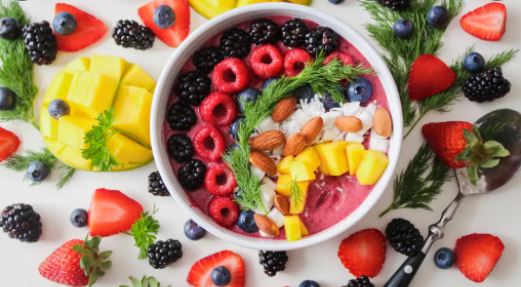Lifestyle
Rainbow diet: Here’s what you should know about this colourful diet plan

When it comes to eating healthy, people are often confused about what should they be eating, how their plate should look like, which vegetables and fruits they should be eating, etc.
The simplest way to make sure you are eating well is to look out for a rainbow on your plate. So, in this article we’ll give you a complete guide on Rainbow diet.
What is Rainbow diet?
Making your plate look like a rainbow means, making your plate as colourful as possible like adding foods that are differently coloured, like green, red, purple, yellow, orange, pretty much like a colourful rainbow. Consuming a rainbow of fruits and vegetables ensures that you not only get enough of the different nutrients, antioxidants, vitamins, minerals which are necessary for the overall health of the body.
Importance of colours on foods?
Every fruit or vegetable colour has a deep meaning behind it. These colours are due to the presence of an array of unique disease-fighting chemicals called ‘phytonutrients’ and each colour stands for a unique phytochemical.
It is these phytochemicals, which give the fruits and vegetables a unique vibrant colour and numerous health benefits along with it. By eating all the colours of the nutritional rainbow, you will harness the power of these cancer-fighting and immune-boosting foods.
So how do you build a rainbow plate and what does each colour signify?
1. Lycopene (red colour)
Lycopene reduces the risk of breast and prostate cancer. The pigment boosts heart, brain, eye, and bone health. Red coloured foods are watermelon, tomatoes, strawberries, red bell pepper, and grapefruit.
2. Beta-carotene (orange colour)
Beta carotene is a precursor to Vitamin A and has anti-cancer properties, reduces inflammation, supports the immune system, and boosts vision. Foods rich in beta-carotene are carrots, apricot, spinach, yellow pumpkin, and sweet potatoes.
3. Vitamin C and flavonoids (yellow colour)
Vitamin C-rich foods are brimming with antioxidants, help inhibit tumour cell growth, detoxify harmful substances, boost your immune system, reduce inflammation, and improve heart health. Vitamin C is generally found in citrus fruits like oranges, papayas, and lemons, kale, strawberries and broccoli.
4. Folate (deep dark green colour)
Folate-rich foods help build healthy cells and genetic material and boosts heart health. They are iron-rich and help maintain healthy hemoglobin levels. They are also rich in chlorophyll, a plant pigment that helps in increasing oxygenation levels of the blood and acts as a blood purifier. Foods like eggs, citrus fruits, asparagus, legumes, leafy greens, Brussel sprouts, and beetroots leaves are rich in folate.
5. Indoles and lutein (light green colour)
Rich in sulphur, Indoles eliminates excess estrogen and carcinogens and support eye health. Foods containing indoles are cabbage, Brussels sprouts, kale, mustard greens, and broccoli.
6. Anthocyanins (blue-purple colour)
Anthocyanins destroy free radicals, reduce inflammation, and are beneficial for the brain. Anthocyanins are found in foods like eggplant, blueberries, plums, cherries, and grapes.
7. Resveratrol (pink colour)
Resveratrol helps decrease estrogen production, boost heart health and brain health. Foods rich in resveratrol are peanuts, dark chocolate, cranberries, and grapes.
8. Fibre (brown colour)
Fibre again offers a wide range of health benefits. It helps balance sugar levels, reduces blood sugar spikes, regulates bowel movements, lipid control, digestive health, and aids in weight management. Apart from this, it also removes carcinogens. Fresh fruits, dark green vegetables, healthy nuts and seeds, and whole grains are all rich in fibre.
Ways one could add this rainbow to their plates?
Stir fry vegetables or sautéed vegetables, salad, chopped vegetables to dals, soups, vegetable sticks with healthy dips, pulao with vegetables like green peas, beetroot, carrots, beans etc. can help you have a proper Rainbow Diet.







